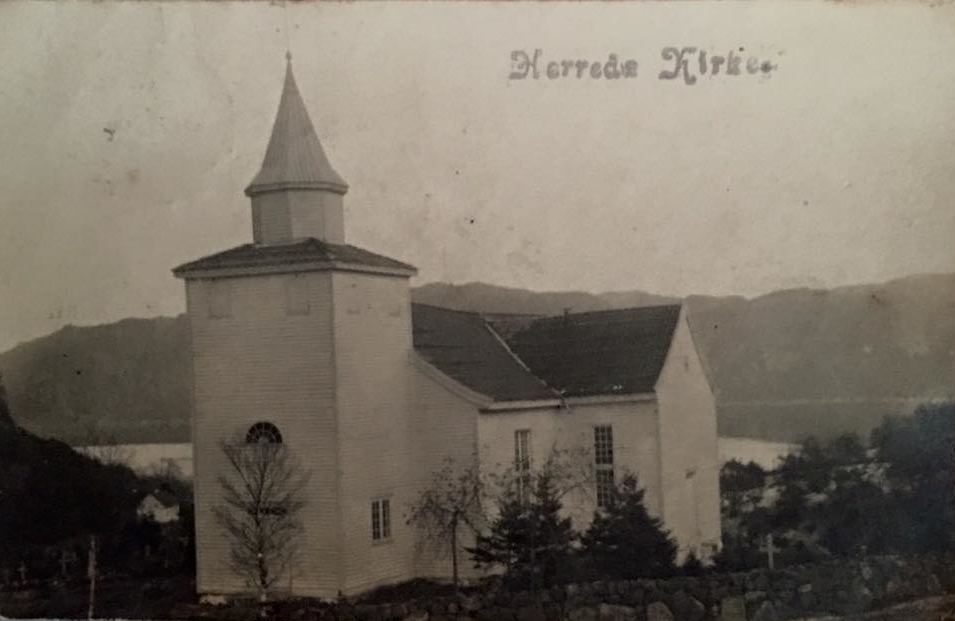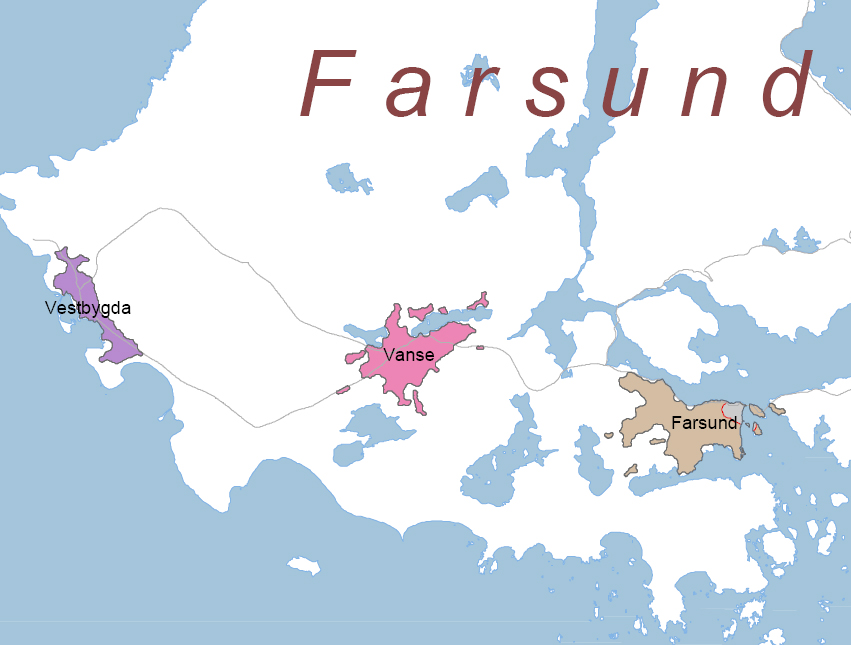|
Herad Church (Vest-Agder)
Herad Church ( no, Herad kirke) is a parish church of the Church of Norway in Farsund Municipality in Agder county, Norway. It is located in the village of Sande, Agder, Sande, along the Åptafjorden. It is one of three churches for the Farsund parish which is part of the Lister og Mandal prosti (deanery) in the Diocese of Agder og Telemark. The white, concrete church was built in a Churches in Norway#Floor plan, long church design in 1957 using plans drawn up by the architect Christen A. Christensen. The church seats about 170 people. History The first church was probably constructed in Herad in 1570. It was a timber-framed church with a rectangular nave and a narrower, rectangular chancel. In 1840, a new cruciform church was built about to the southwest of the church. When the new church was completed, the old church was torn down. In 1948, the church burned down. As this was during the aftermath of World War II, funds were tight and the church was not rebuilt until 1957. The ... [...More Info...] [...Related Items...] OR: [Wikipedia] [Google] [Baidu] |
Farsund Municipality
is a municipality in Agder county, Norway. It is located in the traditional district of Lister. The administrative centre of the municipality is the town of Farsund. Farsund is a coastal municipality in the far southwestern part of Norway, bordering Kvinesdal municipality in the north and Lyngdal in the north and east. The municipality is the 276th largest by area out of the 356 municipalities in Norway. Farsund is the 116th most populous municipality in Norway with a population of 9,622. The municipality's population density is and its population has increased by 2% over the previous 10-year period. The inhabitants of Farsund are concentrated in three centres of population: the town of Farsund (population: 3,265), Vanse (population: 2,016), and Vestbygda (population: 1,123). Loshavn with its wooden buildings is located outside the town of Farsund. Other villages in Farsund include Ore, Rødland, and Sande. General information The town of Farsund was established ... [...More Info...] [...Related Items...] OR: [Wikipedia] [Google] [Baidu] |
Deanery
A deanery (or decanate) is an ecclesiastical entity in the Roman Catholic Church, the Eastern Orthodox Church, the Anglican Communion, the Evangelical Church in Germany, and the Church of Norway. A deanery is either the jurisdiction or residence of a dean. Catholic usage In the Catholic Church, Can.374 §2 of the Code of Canon Law grants to bishops the possibility to join together several neighbouring parishes into special groups, such as ''vicariates forane'', or deaneries. Each deanery is headed by a vicar forane, also called a dean or archpriest, who is—according to the definition provided in canon 553—a priest appointed by the bishop after consultation with the priests exercising ministry in the deanery. Canon 555 defines the duties of a dean as:Vicars Forane (Cann. 553–555) from the |
Churches In Agder
Church may refer to: Religion * Church (building), a building for Christian religious activities * Church (congregation), a local congregation of a Christian denomination * Church service, a formalized period of Christian communal worship * Christian denomination, a Christian organization with distinct doctrine and practice * Christian Church, either the collective body of all Christian believers, or early Christianity Places United Kingdom * Church (Liverpool ward), a Liverpool City Council ward * Church (Reading ward), a Reading Borough Council ward * Church (Sefton ward), a Metropolitan Borough of Sefton ward * Church, Lancashire, England United States * Church, Iowa, an unincorporated community * Church Lake, a lake in Minnesota Arts, entertainment, and media * '' Church magazine'', a pastoral theology magazine published by the National Pastoral Life Center Fictional entities * Church (''Red vs. Blue''), a fictional character in the video web series ''Red vs. Blue'' * Chur ... [...More Info...] [...Related Items...] OR: [Wikipedia] [Google] [Baidu] |
Farsund
is a municipality in Agder county, Norway. It is located in the traditional district of Lister. The administrative centre of the municipality is the town of Farsund. Farsund is a coastal municipality in the far southwestern part of Norway, bordering Kvinesdal municipality in the north and Lyngdal in the north and east. The municipality is the 276th largest by area out of the 356 municipalities in Norway. Farsund is the 116th most populous municipality in Norway with a population of 9,622. The municipality's population density is and its population has increased by 2% over the previous 10-year period. The inhabitants of Farsund are concentrated in three centres of population: the town of Farsund (population: 3,265), Vanse (population: 2,016), and Vestbygda (population: 1,123). Loshavn with its wooden buildings is located outside the town of Farsund. Other villages in Farsund include Ore, Rødland, and Sande. General information The town of Farsund was established ... [...More Info...] [...Related Items...] OR: [Wikipedia] [Google] [Baidu] |
List Of Churches In Agder Og Telemark
This list of churches in Agder og Telemark is a list of the Church of Norway churches in the Diocese of Agder og Telemark in Agder and Vestfold og Telemark counties in southern Norway. The diocese is based at the Kristiansand Cathedral in the city of Kristiansand. The diocese includes all of Agder county and the majority of Vestfold og Telemark county, with the exception of the far eastern part of that county which belongs to the Diocese of Tunsberg. This list is divided into nine sections, one for each Deanery ( no, prosti) in the diocese. Administratively within each deanery, the churches are divided by municipalities, each of which have their own church council (). Each municipal church council may be made up of more than one parish (), each of which may have their own council (). Each parish may have one or more congregations in it. Kristiansand domprosti This arch-deanery covers all the churches within the municipality of Kristiansand in southern Agder county. The arch-de ... [...More Info...] [...Related Items...] OR: [Wikipedia] [Google] [Baidu] |
Norwegian Directorate For Cultural Heritage
The Directorate for Cultural Heritage ( no, Riksantikvaren or ''Direktoratet for kulturminneforvaltning'') is a government agency responsible for the management of cultural heritage in Norway. Subordinate to the Norwegian Ministry of the Environment, it manages the '' Cultural Heritage Act of June 9, 1978''. The directorate also has responsibilities under the Norwegian Planning and Building Law. Cultural Heritage Management in Norway The directorate for Cultural Heritage Management is responsible for management on the national level. At the regional level the county municipalities are responsible for the management in their county. The Sami Parliament is responsible for management of Sámi heritage. On the island of Svalbard the Governor of Svalbard has management responsibilities. For archaeological excavations there are five chartered archeological museums. History The work with cultural heritage started in the early 1900s, and the first laws governing heritage findings came ... [...More Info...] [...Related Items...] OR: [Wikipedia] [Google] [Baidu] |
World War II
World War II or the Second World War, often abbreviated as WWII or WW2, was a world war that lasted from 1939 to 1945. It involved the vast majority of the world's countries—including all of the great powers—forming two opposing military alliances: the Allies and the Axis powers. World War II was a total war that directly involved more than 100 million personnel from more than 30 countries. The major participants in the war threw their entire economic, industrial, and scientific capabilities behind the war effort, blurring the distinction between civilian and military resources. Aircraft played a major role in the conflict, enabling the strategic bombing of population centres and deploying the only two nuclear weapons ever used in war. World War II was by far the deadliest conflict in human history; it resulted in 70 to 85 million fatalities, mostly among civilians. Tens of millions died due to genocides (including the Holocaust), starvation, ma ... [...More Info...] [...Related Items...] OR: [Wikipedia] [Google] [Baidu] |
Cruciform
Cruciform is a term for physical manifestations resembling a common cross or Christian cross. The label can be extended to architectural shapes, biology, art, and design. Cruciform architectural plan Christian churches are commonly described as having a cruciform architecture. In Early Christian, Byzantine and other Eastern Orthodox forms of church architecture this is likely to mean a tetraconch plan, a Greek cross, with arms of equal length or, later, a cross-in-square plan. In the Western churches, a cruciform architecture usually, though not exclusively, means a church built with the layout developed in Gothic architecture. This layout comprises the following: *An east end, containing an altar and often with an elaborate, decorated window, through which light will shine in the early part of the day. *A west end, which sometimes contains a baptismal font, being a large decorated bowl, in which water can be firstly, blessed (dedicated to the use and purposes of God) and ... [...More Info...] [...Related Items...] OR: [Wikipedia] [Google] [Baidu] |
Chancel
In church architecture, the chancel is the space around the altar, including the choir and the sanctuary (sometimes called the presbytery), at the liturgical east end of a traditional Christian church building. It may terminate in an apse. Overview The chancel is generally the area used by the clergy and choir during worship, while the congregation is in the nave. Direct access may be provided by a priest's door, usually on the south side of the church. This is one definition, sometimes called the "strict" one; in practice in churches where the eastern end contains other elements such as an ambulatory and side chapels, these are also often counted as part of the chancel, especially when discussing architecture. In smaller churches, where the altar is backed by the outside east wall and there is no distinct choir, the chancel and sanctuary may be the same area. In churches with a retroquire area behind the altar, this may only be included in the broader definition of chancel. I ... [...More Info...] [...Related Items...] OR: [Wikipedia] [Google] [Baidu] |
Nave
The nave () is the central part of a church, stretching from the (normally western) main entrance or rear wall, to the transepts, or in a church without transepts, to the chancel. When a church contains side aisles, as in a basilica-type building, the strict definition of the term "nave" is restricted to the central aisle. In a broader, more colloquial sense, the nave includes all areas available for the lay worshippers, including the side-aisles and transepts.Cram, Ralph Adams Nave The Catholic Encyclopedia. Vol. 10. New York: Robert Appleton Company, 1911. Accessed 13 July 2018 Either way, the nave is distinct from the area reserved for the choir and clergy. Description The nave extends from the entry—which may have a separate vestibule (the narthex)—to the chancel and may be flanked by lower side-aisles separated from the nave by an arcade. If the aisles are high and of a width comparable to the central nave, the structure is sometimes said to have three naves. ... [...More Info...] [...Related Items...] OR: [Wikipedia] [Google] [Baidu] |





